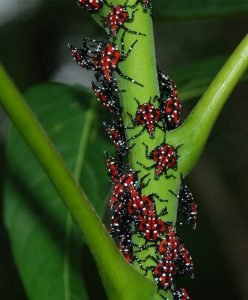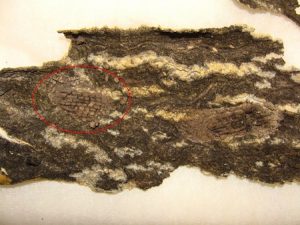A New Threat to Virginia
By Joe Francis, Fairfax Master Gardener
 The spotted lanternfly was initially classified in the genus Aphaena and described by Adam White based on his observations in its habitat near Nanking, China in 1845. It was subsequently reclassified in the genus Lycorma as the species L. delicatula. It is native to China, where historic references to its existence abound dating back to the 12th century. It is also native to India and Vietnam. In these regions, it is kept in check by natural predators and regional pathogens.
The spotted lanternfly was initially classified in the genus Aphaena and described by Adam White based on his observations in its habitat near Nanking, China in 1845. It was subsequently reclassified in the genus Lycorma as the species L. delicatula. It is native to China, where historic references to its existence abound dating back to the 12th century. It is also native to India and Vietnam. In these regions, it is kept in check by natural predators and regional pathogens.
L. delicatula was accidentally introduced onto the Korean Peninsula in 2006 and is now listed as a major pest there. In 2014, this plant hopper was found in Berks County, Pennsylvania and its presence traced back to eggs attached to packing materials in a 2012 architectural stone shipment from China. In January 2018, the pest was observed in Frederick County, Virginia.
The spotted lanternfly is 1 inch long and ½ inch wide and is classified in the family of the Fulgorid insects. It is a strong jumper and generally moves between locations by hops rather than the use of its wings. The lantern analogy origin is attributed to the inflated portion of its head that was thought to be luminous.
An adult lanternfly has a black head and grayish wings containing the readily identified black spots, and the body seems to glow red. The wing tips at rest are covered with black and gray spots that have a pattern of brick and mortar joints.
In flight, it displays red hind wings with black spots on the proximal third of the wing surface, a white wedge in the middle of the wings and solid black wing tips. The abdomen is yellow with black and white bands on both upper and lower surfaces.

Nymphs
The infection on the Korean Peninsula initially noticed in 2004 and the counter measure experience of the Korean government to deal with this invasion for the next decade is instructive. Because of their preference for grape and stone fruit trees (such as peach, plum and cherry) as hosts, and their wide availability in California, the Western Farm Press reported early and often on this invasion and its countermeasures. This dose of contemporary experience gives the Extension Services in Maryland and its adjacent Commonwealth states of Pennsylvania and Virginia contemporary pest management examples.
The Western Farm Press staff reprinted a summary paper in 2014 on the field observations following the hectic spread of the Spotted Lanternfly in Korea, and here is an excerpt:
“The spotted lanternfly feeds on a variety of host plants including vines, fruit trees, ornamental trees, and woody trees. Apples, birch, cherry, dogwood, grapes, lilac, maple, poplar, stone fruits and tree-of-heaven are among more than 70 species of hosts attacked by the pest.”
“Observations in South Korea suggests that spotted lanternfly appears to have a wider host range early in life as young nymphs, and a narrow range as they grow older, especially before egg laying. Choosing plants with toxic metabolites for egg laying is thought to be a mechanism of defense to protect from natural enemies.”
“Although grape vine does not have toxic metabolites like other hosts, spotted lanternfly showed a strong preference [for them] in studies conducted in South Korea. The sugar content of the host plant also appears to play a role in their choice with a preference for hosts containing high sucrose and fructose content.”

Egg masses
As early as July, the adults will be seen foraging indiscriminately and as fall and the mating season arrives, they will narrow their activity preferably to hosts with toxic metabolites. Egg masses of 30 to 50 eggs will be laid in September until winter’s onset vertically on any smooth surface –- their preference being to deposit their egg masses on the toxic metabolite hosts to ward off predators. These masses are covered by the adults in a yellowish brown, waxy deposit for protection from the elements during dormancy. The insect’s life expectancy is one year.
Virginia’s current Pest Management Guide has no recommendations at this writing. Sightings of this pest should be immediately reported to the local Virginia Cooperative Extension Office, and specimens should be brought to their office for identification. For further questions, contact the Virginia Cooperative Extension Help Desk at 703-324-8556.
References
Spotted Lanternfly, Virginia Cooperative Extension
(https://extension.psu.edu) Penn State Extension various articles on identification, egg mass removal and vigilance
Spotted lanternfly – a new threat to grape, stone fruit?, Western Farm Press
Spotted lanternfly, Wikipedia